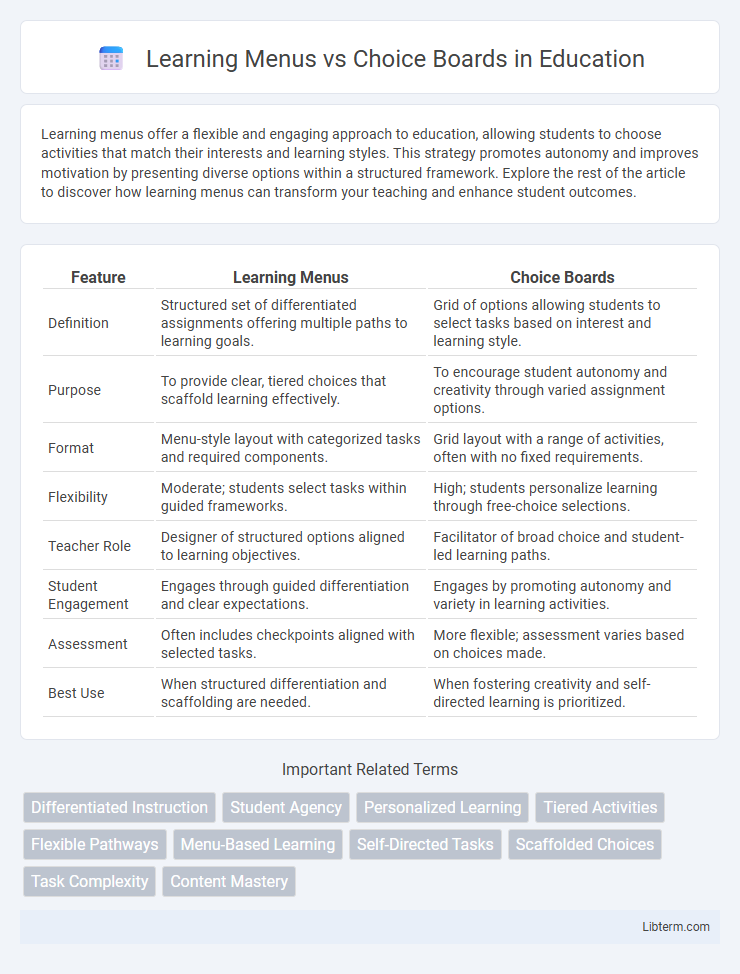Learning menus offer a flexible and engaging approach to education, allowing students to choose activities that match their interests and learning styles. This strategy promotes autonomy and improves motivation by presenting diverse options within a structured framework. Explore the rest of the article to discover how learning menus can transform your teaching and enhance student outcomes.
Table of Comparison
| Feature | Learning Menus | Choice Boards |
|---|---|---|
| Definition | Structured set of differentiated assignments offering multiple paths to learning goals. | Grid of options allowing students to select tasks based on interest and learning style. |
| Purpose | To provide clear, tiered choices that scaffold learning effectively. | To encourage student autonomy and creativity through varied assignment options. |
| Format | Menu-style layout with categorized tasks and required components. | Grid layout with a range of activities, often with no fixed requirements. |
| Flexibility | Moderate; students select tasks within guided frameworks. | High; students personalize learning through free-choice selections. |
| Teacher Role | Designer of structured options aligned to learning objectives. | Facilitator of broad choice and student-led learning paths. |
| Student Engagement | Engages through guided differentiation and clear expectations. | Engages by promoting autonomy and variety in learning activities. |
| Assessment | Often includes checkpoints aligned with selected tasks. | More flexible; assessment varies based on choices made. |
| Best Use | When structured differentiation and scaffolding are needed. | When fostering creativity and self-directed learning is prioritized. |
Understanding Learning Menus
Learning menus present a structured yet flexible approach where students select tasks from categorized options aligned with specific learning objectives, promoting personalized learning paths. These menus often include starters, main activities, and extensions, allowing learners to engage at varying levels of complexity and depth. Understanding learning menus involves recognizing their role in fostering student autonomy while ensuring content coverage and skill development through thoughtfully designed task tiers.
What Are Choice Boards?
Choice boards are interactive learning tools that present students with a grid of diverse activities catering to different learning styles and preferences. These boards empower students to select tasks that align with their strengths and interests, enhancing engagement and motivation. By offering structured options within a flexible framework, choice boards promote autonomy and personalized learning paths.
Key Differences Between Learning Menus and Choice Boards
Learning menus provide students with a structured set of tasks organized like a meal menu, allowing them to select activities from different categories that vary in complexity and format to enhance differentiated learning. Choice boards present a grid or matrix format offering options for students to choose from, typically emphasizing student autonomy by enabling selection within a defined set of options aligned with learning objectives. The key difference lies in the organization and presentation: learning menus categorize tasks with specific sections resembling appetizer, main course, and dessert, whereas choice boards use a more flexible grid layout promoting a broader range of choice.
Benefits of Using Learning Menus
Learning menus offer personalized learning pathways that accommodate different student interests and learning styles, enhancing engagement and motivation. They provide clear structure with defined tasks and choices, promoting student autonomy while ensuring curriculum alignment. This approach supports differentiated instruction by allowing learners to progress at their own pace and demonstrate mastery in diverse ways.
Advantages of Implementing Choice Boards
Choice boards enhance student autonomy by offering diverse learning options tailored to various learning styles and preferences. They promote engagement and motivation through personalized activities, fostering deeper understanding and retention of content. This approach supports differentiated instruction effectively, accommodating individual strengths and pacing without overwhelming educators.
Choosing the Right Option for Your Classroom
Learning menus offer students a structured set of tasks categorized by difficulty or topic, promoting gradual skill development and clear learning pathways. Choice boards provide a grid of diverse activities allowing learners to select based on interests and learning styles, fostering autonomy and engagement. Selecting between learning menus and choice boards depends on classroom goals, student autonomy levels, and desired differentiation, ensuring alignment with curriculum standards and individual learner needs.
Student Engagement: Menus vs Choice Boards
Learning menus and choice boards both enhance student engagement by offering personalized learning pathways tailored to individual interests and skill levels. Learning menus provide structured options categorized by tasks and difficulty, allowing students to select activities that match their readiness, while choice boards offer a flexible grid of varied activities promoting autonomy and creativity. Both tools increase motivation and active participation by empowering students with meaningful choices aligned to educational goals.
Differentiation Opportunities Compared
Learning menus offer structured differentiation by providing tiered tasks tailored to varied student readiness levels, learning styles, and interests, allowing for personalized pacing and content depth. Choice boards enable broader learner autonomy through a grid of diverse activities, promoting student voice and engagement by allowing selection based on preference and strengths. Both strategies enhance differentiation but learning menus prioritize scaffolding and sequential complexity, whereas choice boards emphasize flexibility and creativity in task selection.
Best Practices for Design and Implementation
Effective design of learning menus and choice boards centers on clarity, alignment with learning objectives, and varied student engagement options that cater to diverse learning styles. Implementing these tools involves providing structured yet flexible paths that encourage student autonomy, incorporate formative assessment checkpoints, and use technology for easy access and tracking progress. Best practices emphasize ongoing feedback, scaffolding tasks by difficulty, and fostering critical thinking through meaningful choice.
Teacher Tips: Maximizing Success with Student Choice
Learning menus and choice boards empower teachers to enhance student engagement by offering structured yet flexible options tailored to diverse learning preferences. Teachers should align menu tasks with curriculum goals, ensuring each choice addresses key standards while promoting critical thinking and skill development. Incorporating clear instructions, varied activity formats, and scaffolding supports maximizes student autonomy and success in differentiated learning environments.
Learning Menus Infographic

 libterm.com
libterm.com